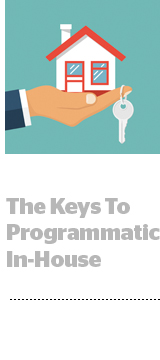
More brands are bringing the strategic functions of programmatic buying in-house, relegating their agencies to specialized roles.
Sixty-five percent of brands are either completely or partially buying programmatic media in-house, according to a white paper released Tuesday by the Interactive Advertising Bureau’s (IAB) Data Center of Excellence. The white paper surveyed marketers at 119 US brands across 16 verticals.
Brands are bringing programmatic in-house to gain more control over their media buying and data strategies, said Orchid Richardson, VP managing director at the IAB Data Center of Excellence. By getting closer to the systems and tools used to buy media, brands can better control targeting and effectiveness to drive ROI.
“It has to do with [agencies’] ability to optimize quickly,” Richardson said. “It’s several layers of people to get through to make those adjustments. When there’s a chain of command, the sheer time it takes has a negative impact on ROI.”
Brands also want more control over their data. Rather than handing all of their assets over to an agency for targeting, they want to create audiences and lookalike models in their data management platforms and control how that data flows to the demand-side platform (DSP) for media execution.
“The introduction of our first-, second- and third-party data into the DSP has been a real game-changer if you flash back [to] a year ago where we were just running through the agency trading desk,” a financial services marketer told the IAB.
Brands are also bringing programmatic in-house to drive cost efficiencies as marketers struggle with low growth and look to slash agency budgets. With in-house programmatic, brands can ensure that their budgets are flowing to their own initiatives rather than agency margins.
“Cost transparency and control was a significant driver for why they’re making the transition,” Richardson said. “If they’re able to reduce that cost by doing programmatic themselves, that’s the motivator.”
The reality
Despite a thirst for control, just 18% of brands have taken programmatic fully in-house, which the IAB defines as “when an ad tech stack sits within the brand organization along with media strategy, ad operations, optimization and stewardship.”
Meanwhile, 47% of brands have brought parts of programmatic in-house, like media and data strategy, while relying on agencies for specialized functions such as ad ops, data science and coding, the report found.
While brands also want to take optimization and analytics in-house, they often don’t yet have the expertise to do so. So, where they can, agencies are helping brands plug holes in their in-house programmatic operations.
“Often times it comes down to creative development or research,” Richardson said. “Brands are still turning to their agencies to develop some strategy and creative.”
Whether agencies are trading long-term sustainability for short-term gain under that model remains to be seen, Richardson said.
“There’s value in the agency, but they bring a different value than media buying going forward,” she said. “We’ll have to see over time how that evolves.”
The commitment
Brands either fully or partially taking programmatic in-house should know it isn’t as simple as plugging in a piece of technology.
Marketers hoping to bring programmatic in-house first need to prove it will create more efficiencies for the organization than working with an agency. Then, they need to get buy-in on a formal plan from the C-suite.
Once approved, marketers have to centralize their data infrastructure, stand up a tech stack, coordinate contracts and hire competitive programmatic experts to run the organization.
The whole process can take anywhere from 12 to 18 months, and it often requires help from an outside consultant or agency, Richardson said.
“It’s definitely a process,” she said. “They start small with one part of programmatic before they decide to go full-blown into it.”
While brands can train some people within their organization quickly, they’ll need to recruit outside specialists for the programmatic team. Brands should consider where they’re located and whether or not they’re equipped to find that talent before bringing programmatic in-house, the report said.
Sometimes the costs of in-housing are too much for brands to handle. Thirteen percent of brands surveyed pulled out of in-housing initiatives after testing, according to the IAB.
“They find it’s more complicated than they thought it was,” Richardson said. “You really have to take the time to invest in the right talent, systems and structures in order to make that happen.”
But for brands well-positioned to take programmatic in-house, the benefits are “definitely material” if the process is approached in the right way, Richardson said.
“Don’t try to jump into it right away,” Richardson said. “Once you’ve outlined the process, make the right investments along the way, whether that’s in people or systems. Make sure you’re doing it as a phased approach.”
Going forward, the IAB expects to see a rise in hybrid in-housing models as brands clamor for more control over their data and ad spend.
“And as the hybrid model market matures, more people will take the whole thing in-house,” Richardson said.
Update: The original version of this story said 70% of brands have fully or partially taken programmatic in-house. That number is 65%.
This post was syndicated from Ad Exchanger.

More Stories
Is Tegna Looking to Hub Weather in Its Local Markets?
Stuff Group taps Belinda Francis to lead North Island Markets
Veteran Meteorologist James Spann Voices Support for NOAA and NWS in Anticipation of Trump Cuts